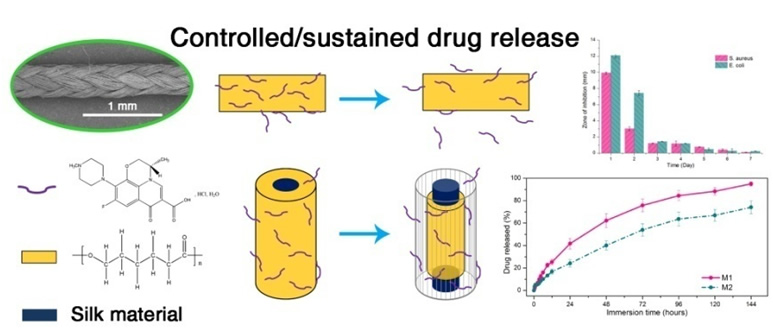Recently, Prof. Lu Wang, the professor of Textile College of Donghua University, guided the biomedical textile materials group to collaborate with Prof. Gang Sun, the professor of the University of California, Davis. Theco-authored research paper Antibacterial Surgical Silk Sutures Using a High-Performance Slow-Release Carrier Coating System was published in ACS Applied Materials & Interfaces, one of the most authoritative international magazines in the field of material interfaces research (ACS Appl. Mater. Interfaces 2015, 7, 22394-22403).
Surgical site infections (SSIs) are both common postoperative infections, and major postoperative complications.SSIs always prolonged length of stay in hospitals and added extra cost. Currently, surgeons indicated that suture materials with antibacterial treatment showed feasibility of inhibiting bacterial growth in wounds. As a foreign body, antibacterial sutures may prevent the attachment and proliferation of bacteria, as well as reduce the probability of SSIs.
This paper established a novel controlled/sustaineddrug release system, which using levofloxacin hydrochloride as the antibacterial drug, and polycaprolactone as the drug carrier.This system was successfully applied to the preparation of surgical silk suture materials.Then, the non-absorbable antibacterial silk sutures with a slow-release antibacterial effect was obtained, by coordinating braiding techniques with antibacterial treating processes and by optimizingtechnical parameters. The antibacterial silk sutures had good industrialization potential. The durations of inhibition zones maintained varying 5 to 7 days, which were in keeping with wound healing rate. Besides, the sutures showed good physical and handling properties, which were reached the relevant requirements for clinical practice.
According to theoretical analysis, the article also proved that the controlled/sustained drug release was related to both diffusion of drug in aqueous medium and the hydrolytic degradation of dosage.Thisconclusion was in accord with the lab results. Therefore, the related research may not only provide a new guidance for the accurate control of this novel controlled/sustained drug release system, but also lay a theoretical basis for functionalization of surgical silk sutures, one of unique resources in China.
This work was financially supported by the 111 project Biomedical Textile Materials Science and Technology (B 07024) and the China Scholarship Council Fund (No. 201406630047), and the Chinese Universities Undergraduate Innovative Fund (No. DHU2012047).


